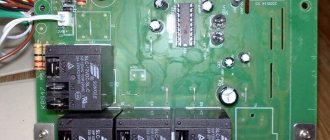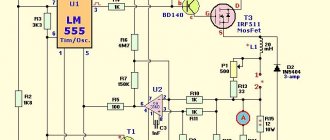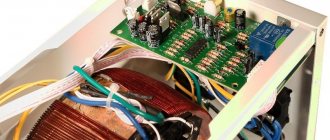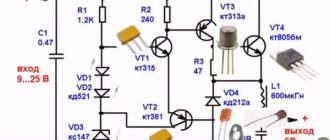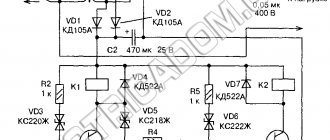Unfortunately, domestic electrical networks cannot boast of voltage stability. And if in big cities this problem is not acute, then in small towns and villages this is the biggest problem, which leads to incorrect operation of electrical household appliances and lighting. What to do? There is only one way out - install a voltage stabilizer. These devices are presented in a wide range on the market. In this same article I would like to talk about a brand such as the Resanta stabilizer from the Latvian company of the same name, which has been selling its devices on the Russian market for 15 years.
Voltage stabilizer Resanta
Device parameters
Since the Resanta ASN-10000 voltage stabilizers are electrical products, the most important part of them is the technical parameters. The following points need to be highlighted here:
- type of connected network - single-phase;
- operating input voltage range - 140-260 V;
- the power of these copies is 10 kW;
- output voltage is 220 V;
- This device is connected to the network through special terminal blocks;
- there is a bypass;
- the efficiency of the device is 97%;
- operating temperature of the device is from 0 to 45 degrees Celsius;
- operating air humidity should not exceed 80%;
- the model is relatively heavy - 19.5 kg;
- dimensions - 220x230x385;
- type of installed protection - IP-20.
You may be interested in: ASKO washing machines: reviews from experts
You may be interested in: Power supply for LED lamps: device, principle of operation, expert advice
The brand of the voltage stabilizer "Resanta" ASN-10000/1-Ts is deciphered as follows: automatic voltage stabilizer, power - 10 kVA. The letter H means that the model is wall-mounted, the number 1 indicates the type of network being connected - single-phase. There is also a letter C at the end, indicating the presence of a digital display on the front panel of the device. The incoming voltage will be highlighted in red, and the outgoing voltage in yellow.
External signs of the ASN-10000/1-C normalizer
Floor stabilizer Resanta
The Resanta brand floor relay stabilizer with the same power has a housing with different dimensions. So, it is characterized by a greater depth, which is 38.5 centimeters. The height and width are 23 and 22 centimeters, respectively.
The front side houses three indicators, a digital display, a display control button and a circuit breaker. This switch is no different from the wall stabilizer switch.
The display shows only one digit. This number can indicate either output or input voltage. The screen operating mode is selected using a special button.
On the back side there are connection terminals and a fan. The manufacturer installed two handles on the top side. “Appearance” of the ASN-10000/1-EM normalizer
If we talk about the “appearance” of the electromechanical stabilizer - ASN-10000/1-EM, then on its front side there are:
- Ammeter.
- A voltmeter that can show either the output or input volts.
- Voltmeter operating mode switch.
- Automatic switch (same as the previous two models).
- Three indicators
These indicators report different levels of input volts. The first indicator will light up when the input is more than 260 volts, the second - when the input is less than 260 and more than 140 volts. The third will report a very low voltage (less than 140 V).
On the rear panel there are terminals for connection. There are also ventilation holes on the back and sides. There is no fan.
Technical description
Speaking about the Resanta ASN-10000 voltage stabilizer, we can mention several more important features.
Firstly, the device belongs to the class of household relay economic devices. Its operating range is fairly standard for its class; there are no special nuances or “zest” in the device. The main characteristics of the stabilizer are indicated on its front panel.
You might be interested in:How CCTV cameras work: principles of operation, design and characteristics
Secondly, it is worth saying that the design includes a cooling fan. It does not work constantly, but as the power part of the device heats up. If the temperature reaches a certain value, it turns on. When the readings fall below a certain point, it also turns off automatically. The relay type of device has several stages of adjustment, but is not very accurate. The adjustment accuracy is 8%.
Connection instructions in the panel
First of all, install a three-position switch in the electrical panel, immediately after the input circuit breaker.
- in the first position, when the tongue is raised up, voltage will be supplied to the house directly from the electrical network, without using a stabilizer
What if it breaks down or you need to carry out some revision work. You won’t have to unplug the wires every time and cut off power to the entire apartment.
- in the second position II (the tongue of the machine looks down) - the power supply will go through the stabilizer
- position “0” – all electrical appliances are disconnected, both from the stabilizer and from the external network
Choose a location for installing the voltage stabilizer. You can’t put it anywhere either. There are certain rules that must be followed.
Lay two VVGnG-Ls cables from the panel to this place.
It is advisable to mark each of them and make appropriate inscriptions at both ends:
- stabilizer input
- output from stabilizer
Remove the insulation from the wires and first connect the cable in the electrical panel. Connect the phase from the wire that goes to the input of the stabilizer to the output terminals of the input circuit breaker.
Next, deal with the stabilizer-output cable. Connect the phase conductor (let it be a white wire) to contact No. 2 on the three-position switch.
You connect the neutral and ground from both cables to the appropriate busbars.
Now you need to feed the phase directly from the input machine to the three-position one. You strip the installation wire of the PUGV, terminate the wires with NShVI lugs and lead it from the phase output of the input circuit breaker to terminal No. 4 of the switch.
All that remains to be done in the panel is to power all the machines from terminal No. 1 of the three-position switch.
You perform this operation again with flexible mounting wires.
Thus, according to the diagram, you supplied a phase from the input circuit breaker to the 3-position one, and then distributed the load through its contacts, by connecting through a stabilizer (contact No. 2-No. 1) and directly without it (contact No. 4-No. 1).
In your specific case, these contact numbers may not match the numbers shown here! Be sure to clarify everything in the instructions or in the passport for the machine.
Disadvantage of the device
The device is quite good, with a low cost, and therefore is popular, but it is not without its drawbacks. The main one is that the stabilizer does not turn off when the input voltage increases. Everything is quite simple here. As the input voltage increases, the output voltage also increases. For example, the input voltage can reach 270 V, but the output of the stabilizer can be only 250 V, and it will not turn off.
The termination of its operation will occur automatically only with an even greater increase in voltage, which will still pass through it into the network. In this case, the letter “H” will appear on the indicator on the front panel, and the device will finally stop working. This value on the indicator means that the stabilizer’s overvoltage protection is turned on.
What you need to connect
In addition to the stabilizer itself, you will need a number of additional materials:
- three-core cable VVGnG-Ls
The cross-section of the wire must be exactly the same as on your input cable, which comes to the main input switch or circuit breaker. Since the entire load of the house will go through it.
- three position switch
This switch, unlike simple ones, has three states:
1consumer No.1 is on 2is off 3consumer No.2 is on
You can also use a regular modular circuit breaker, but with this scheme, if you need to disconnect from the stabilizer, you will have to completely de-energize the entire house each time and reconnect the wires.
There is, of course, a bypass or transit mode, but in order to switch to it, you need to follow a strict sequence. This will be discussed in more detail below.
With this switch, you completely cut off the unit with one movement, and the house remains with light directly.
- PUGV wire of different colors
You must clearly understand that the voltage stabilizer is installed strictly before the electric meter, and not after it.
Not a single energy supplying organization will allow you to connect in another way, no matter how much you prove that by doing so, in addition to the electrical equipment in the house, you want to protect the meter itself.
The stabilizer has its own idle speed and also consumes energy, even when operating without load (up to 30 W/h and above). And this energy must be taken into account and calculated.
The second important point is that it is highly desirable that in the circuit up to the connection point of the stabilization device there is either an RCD or a differential circuit breaker.
This is recommended by all manufacturers of popular brands Resanta, Sven, Leader, Shtil, etc. It could be an introductory automatic differential for the whole house, it doesn’t matter. The main thing is that the equipment itself is protected from current leaks.
In the method described below, this option will be considered. After all, very often these devices are hung on the wall in rooms, hallways, freely accessible for touching.
And breakdown of the transformer windings to the housing is not such a rare thing.
Location of device elements
The front panel of the Resanta ASN-10000 voltage stabilizer is standard for such electrical products. The display type of the device is LCD, which is equipped with all powerful models. The indicator is not able to display deviations from the specified values that do not exceed 8%, which is a rather unpleasant moment. At the top of the panel there are devices for displaying operation, protection, and delay.
Naturally, each of the signaling elements is activated at a certain time during the operation of the equipment. On the left side of the panel there is a load indicator, and on the bottom - overload and overheating.
You might be interested in: Designation mAh: what does it mean?
In addition to these elements, there is another two-section switch on the front panel of the Resanta stabilizer. Its left part is responsible for turning on/off the bypass, while the right side is responsible for turning on/off the entire device. If bypass mode is enabled, the input and output voltages will be equal, since the power blocks that correct it are turned off, although the device itself is still considered part of the system.
teplomex.ru
Almost every person in Russia, living both in the private sector and in multi-apartment city buildings, experiences problems with electrical voltage. In order to protect household appliances, as well as electric and gas heating boilers, heaters and other equipment operating from the mains, you need to buy a voltage stabilizer of 220 or 380 Volts.
Today, one of the popular manufacturers on the market is the Resanta voltage stabilizer , which can protect household appliances from power surges, thereby increasing their service life. I propose to analyze in detail the voltage stabilizers of this brand, using the example of the Resanta models “ASN-500/1-Ts”, “ASN-500N/1-Ts” and others, which have similar technical characteristics and reviews.
We will analyze the scope and purpose, device and principle of its operation according to the operating instructions, as well as prices, functions and features of this model. In addition, together we will consider the main malfunctions, breakdowns and methods for eliminating them yourself.
Purpose and use of Resanta voltage stabilizers
AC voltage stabilizers of the Resanta brand are designed to protect various household appliances with unstable voltage in the electrical network. After all, it’s no secret that when the voltage increases above 220 V, any household device connected to the network can fail.
Resanta "ASN-500/1-C" and "ASN-500N/1-C"
The automatic stabilizer of the Resanta brand provides a stable input voltage in the house within the range of 140-260 V, thereby protecting the equipment. This type of stabilizer is used for household use:
— gas boilers for heating; - refrigerator, TV, computer; — various lighting equipment; — electric pumps for heating and water supply; — heaters (convectors, heat guns, etc.)
How to choose a Resanta voltage stabilizer
With a huge range of products, it can sometimes be difficult to navigate when choosing the right device. Before purchasing a voltage stabilizer, you need to consider several basic criteria.
1. Power consumed by household devices.
In order to choose the right stabilizer, it is necessary, first of all, to take into account the power consumption of the equipment that will be connected through it. This value is usually specified in the operating instructions for the household device or indicated on the equipment itself.
Accordingly, the power rating of the voltage stabilizer must be greater than the total power value of the connected devices. Different types of electrical equipment consume, on average, different amounts of energy in an apartment or private house, in kW/hour:
— refrigerator: 400 Watt; — TV: 200 Watt; — computer: 550 Watt; — light bulb: 120 Watt; — wall-mounted gas boiler: 250 Watt; — heating pump: 60 Watt; — household pump for water supply or sewerage: from 200 Watts and above.
Important! You cannot connect the Resanta voltage stabilizer without grounding!
For simple devices with low energy consumption, it will be enough to buy a voltage stabilizer with a power of 500-1000 Watts. For example, the Resanta stabilizer “ASN-500/1-C” or “ASN-500N/1-C”, which can be used for a gas boiler and circulation pump, refrigerator or TV.
If you plan to connect several household appliances at once through a stabilizer, it is recommended to choose a stabilizing device with a power above 1000 Watts. For example: “ASN-1500/1-Ts” (1.5 kW), “ASN-2000/1-Ts” (2 kW), “ASN-3000/1-Ts” (3 kW) or an even larger power reserve and three-phase.
Voltage stabilizer Resanta ASN-500/1-Ts
2. Multiplicity of the starting current of the connected equipment.
This is the ratio of the value of current consumed at the very moment the equipment is turned on to the value of the current in steady state. This parameter can have a value from 3 to 7, and depends on the presence of a soft start system for the equipment, as well as on the type of electric motor.
This must be taken into account due to the fact that when starting electrical equipment, its current consumption is several times higher than when it operates in normal mode. In cases where the value of the starting current is unknown, it is customary to multiply the amount of power consumed by the equipment by three.
Features and design of the voltage stabilizer Resanta ASN-500/1-C and ASN-500N/1-C
Let's look at the two most popular models of single-phase stabilizers of the Resanta brand for household devices: “ASN-500/1-Ts” and “ASN-500N/1-Ts”.
Voltage stabilizer device ASN-5001-Ts
The ASN-500/1-Ts stabilizer model consists of five main elements:
- plastic housing; — autotransformer; — LED display; — control and switching unit; - switch.
When using the ASN-500/1-Ts stabilizer, some symbols are shown on the informative LCD display:
“L” - the stabilizer turns off due to a voltage drop in the network below 140 V; “H” - the stabilizer is turned off because protection against voltage surges above 260 V has been triggered; “CH” - overheating protection is triggered due to several connected devices at once.
Voltage stabilizer device ASN-500N1-Ts
1 - LCD display;
2 - switching input and output voltage; 3 — cord with plug; 4 - fuse; 5 — socket for connecting devices; 6 - switch. Advantages of Resanta brand voltage stabilizers :
— wide input voltage range 140-260 V; — stabilization of the output voltage without distortion of the sinusoid over a wide range; — speed; — presence of a built-in voltmeter to monitor the output voltage; — automatic shutdown when voltage levels are exceeded and short circuit; — efficiency 97%; — LCD display with indication of parameters; — low price: from 1700 rubles.
Resanta voltage stabilizers: technical characteristics of models
Table of technical characteristics of voltage stabilizers
Malfunctions during operation of the Resanta stabilizer and methods for eliminating them
1. The “Network” light does not light up.
The input and output connections may be mixed up or the machine may not be turned on. Also check to see if the fuse has blown.
2. The device does not stabilize the voltage.
It is necessary to check the operation of the input/output button or disable the bypass.
3. The voltage at the output of the stabilizer is less than 220 V.
Check the input voltage and load size.
4. The stabilizer turns off spontaneously.
The protection is triggered when the input voltage increases above 260 V or the load on the stabilizer is exceeded.
We looked at the Resanta voltage stabilizer : technical characteristics and device, operating principle and application for a gas boiler and pump, TV and refrigerator. We examined the main types of “ASN-500/1-C” and “ASN-500N/1-C” and their functions, malfunctions and troubleshooting methods. Now let's watch the video review.
nomortogelku.xyz
Location of terminals for connection
The wires are connected to the stabilizer at its bottom. In this area there is a special hatch that can be removed to get to special terminals with screws for a screwdriver. With their help, the device is connected. Usually, when such equipment is sold, a special document is included with it - an instruction manual. Everything is indicated here, from the connection method to the care methods.
Series "ASN-N/1-C"
We noted earlier that the company also produces stabilizers that can be mounted on a wall. All of them are united under the category “ASN-N/1-C”. This series is better known under another name, namely “LUX”.
As part of this series, stabilizers are produced, the power of which ranges from 500 watts to 12 kilowatts. Of course, they differ from the representatives of the line described above in a different design of the case.
In other words, the Resanta wall-mounted voltage stabilizer, the technical characteristics of which do not differ from the characteristics of floor-standing models, boasts the presence of:
- Wall-mounted version of the case.
- Special fastening
- Expanded display.
Selection of installation location
The process of connecting the device itself is not very complicated, but you still need to know the general principle. Instructions will be given below. But first you need to choose the right place for direct installation of the device, since this is an important part of the entire connection process.
There are several mandatory items that must be completed. They are listed below in order of importance:
- The most important thing is to exclude the possibility of moisture getting on such equipment.
- Be sure to ensure free air circulation around the device body to avoid overheating.
- It is best to install the stabilizer as close to the input panel as possible.
- During installation, you need to remember that electromechanical devices emit characteristic noise during operation, and relay devices, which include ASN-10000/1-Ts, make clicks.
- The unit must be installed in such a way that connection, control and maintenance can be carried out without difficulty.
- The optimal location for such devices is considered to be a wall or shelf.
Features of the Resanta brand
Resanta brand stabilizers have been sold for more than 15 years, and more than one person has been able to evaluate their best and worst sides. It is worth noting that the Resanta brand is famous not only for its stabilizers.
Many people may note that this brand also sells:
- welding and thermal equipment;
- starting devices;
- uninterruptible power supply devices;
- electrical measuring instruments.
Each group of these devices has been on the market for more than a decade and a half. The nice thing is that the company’s employees are constantly working on developing new devices that become more advanced and better.
Products of the Resanta brand
Each Resanta automatic voltage stabilizer can be called budget and one that belongs to the economy class. In other words, many owners of electrical appliances will be pleased with the fact that they have a low price.
Here you should pay attention to the fact that a low price is not evidence of poor quality. Each stabilizer of the brand has undergone a certification procedure, which confirms that its characteristics comply with the requirements that regulate international standards.
In order for voltage stabilizers for the Resanta home to boast good quality and meet the requirements of world standards, they are produced on a modern robotic line.
This line, like most production lines of the world's leading companies, is located in China (this makes it possible to save on labor costs).
Stabilizer connection
You can connect the Resanta ASN-10000 voltage stabilizer only after all the above conditions have been met. To carry out this process, the device has 5 special terminals. Two of them are marked with the letter “L” - these are phase terminals. Two more will be marked “N” - neutral. The last, fifth, terminal is intended for grounding the device.
The process of connecting such units begins with grounding. After this, you can proceed to connecting the input wires. The terminals for their connection are marked with a similar inscription: “INPUT”. Naturally, the phase wire must be connected to the “L” terminal, and the neutral wire to the “N” terminal.
After this, you should turn on the stabilizer and check the presence of voltage at the output. If it is present and within normal limits, then everything is connected correctly. The unit is then turned off again to connect the output wires. The principle of their connection is similar to the input ones.
If there is no voltage at the output, you should usually check that the wires are connected correctly and, if necessary, swap them.
How to choose the right power stabilizer
The choice is based on the power consumption of the consumer. Resanta voltage stabilizers can be connected to one consuming device or to several. Therefore, to calculate power, the total power of all consumers is taken. What is the power of the consumer can be found out from its passport, instructions for use or tag on the case. There are special tables on the Internet in which these indicators are collected.
Attention! If the voltage stabilizer is installed on a device with a reactive load. That is, this device has an electric motor installed, which consumes three to four times more power when starting, then reactive power is taken for the calculation.
If you have determined the total value, then add another 20% to it. This is a kind of reserve that will ensure normal operation of both the stabilizer and consumers. And all this will increase their service life.
Model selection
The choice of model depends on the type of voltage present in the network of your home. If it is always low, then it is better to choose an electromechanical model that will provide high stabilization accuracy. If the voltage in the network constantly fluctuates (up and down), then it is better to install a digital device.
By the way, relay digital models are, in turn, divided according to several other indicators with separate markings. Thus, wall-mounted stabilizers are designated the “LUX” series, compact devices – “C”, and devices for low voltage in the network – “SPN”.
Functionality
So, the basis of the functional features is the trouble-free and correct operation of household appliances at low or high voltage in the network of your home. In addition, Resanta stabilizers provide certain protection to household appliances, which affects the long-term service life of the latter.
At the same time, the stabilizer itself controls the input and output voltage in automatic mode, maintaining the latter indicator at the nominal value.
EM stabilizers
This company produces another device with a power of 10 kW - the Resanta voltage stabilizer ASN 10000/1-EM. As for the main technical indicators, this device is in many ways similar to the 1-C model. Its power is also 10 kW. The operating voltage range is 140-260 V. However, the actual power will drop when the voltage drops below 190 V, and when working with a minimum input of 140 V, it will drop to half of the initial value. The efficiency of this model is also 97%.
The main difference between these models is the accuracy of adjustment. If the 1-C indicator was 8%, which is quite bad, then the 1-EM model had an accuracy of 2%, which is considered an excellent indicator. In addition to the difference in accuracy, there is also a difference in design. Equipment of the 1-EM brand is distinguished by electromechanical switching, and not relay switching, like 1-C.
However, because of this, it is worth paying attention to such a parameter as the stabilization speed. 1-EM is designed for long-term operation with low or high voltages. The stabilization speed of the electromechanical device is 1-2 seconds. The relay device is characterized by a speed of 20 milliseconds. That is, 1-C will be more preferable in networks with frequent changes due to a faster response to these changes.
Types of Resanta stabilizers
What does the Latvian company offer today? There are two varieties in stock:
- Electromechanical stabilizers.
- Electronic digital.
The first type of design is based on two electrical devices: an autotransformer and a servo drive. It is with their help that smooth and accurate voltage regulation from the network is carried out. All indicators are displayed on the housing panel, which are shown by a voltmeter and an ammeter. Stabilizers with a power of over 5 kW are equipped with an additional two graphite brushes. This ensures a reduction in overheating of the device, and, accordingly, an increase in its service life.
A temperature sensor is also inserted into the design, which monitors fluctuations in heating temperature and gives a signal if overheating becomes higher than normal. The main advantage of Resanta electromechanical stabilizers is stable operation and resistance to voltage overloads. Today, these devices are most often used in everyday life when connecting household and computer equipment.
Electromechanical model
The digital type is based on an autotransformer and electronic keys. These devices are characterized by fast switching, that is, voltage equalization to the nominal voltage. This usually takes half a second. This is a modern device with a modern design, where there is a panel with a display that displays two voltages: input and output. Service messages also come here. In addition, Resanta electronic stabilizers are compact devices with low weight. So you can place them in any place convenient for you.
There is another classification based on the type of connection. Here the division is made into:
- Single-phase.
- Three-phase.
The first ones are used in an alternating current network with a voltage of 220 volts. These are small devices with a power from 0.5 to 30 kW. The second are devices that operate only from a 380-volt network. By the way, they equalize the input voltage in the range of 240-430 volts. The power of Resanta three-phase voltage stabilizers is 3-150 kW.
"Resanta" Lux
The Resanta ASN-10000 Lux voltage stabilizer is very similar in its characteristics to the 1-Ts model. The device also belongs to the relay models, has forced cooling and protection against overheating, short circuit and other things. It has a weak accuracy of 8%, etc. It is worth saying that the input frequency with which it can operate is in the range of 50-60 Hz. In addition, the device will be somewhat larger in size - 305x360x190 mm, which is why it will be somewhat heavier. This should be taken into account when installing the unit.
If we talk about malfunctions of the Resanta ASN-10000 voltage stabilizer, then for electromechanical models these are frequent voltage drops. Because of them, the winding elements become very hot and the motor may fail.
Relay devices have approximately the same basic malfunction, but it consists in the failure of the relay itself. The more often the jumps occur, the faster it wears out.
Comments:
Palych
Who can tell me if 10 kW will be enough for a three-room apartment and a family of 4 people? Or should we look for an even more powerful option?
Mark
Palych, it all depends on the number of pantographs that you are going to connect. Most high-power heating devices do not require a stabilizer. For example, a water heater, hob, electric oven or electric fireplace. And others are required to be connected - an electric pump, a heating boiler, media equipment, a computer, etc. In general, you need to calculate and then you will understand whether such power will be enough for you.
Matchmaker
It’s strange, on the body of the stabilizer it is written that it is electronic, but in fact it is of a different type? Why is that?
Neoh
Swat, you are probably confusing thyristor and relay stabilizers. And they are all electronic, because... run on electricity
Sergey
I can’t find a relay for Resanta 10000. Tell me where I can buy it.
Sasha
if the fan turns on, this is normal or the load is critical or the room is hot
Igor
Tell me, if the constant load is 7 kW 24/7 for months, how long will this device last?
Andrey
connection and resant cable cross-section 10000 W per consumer, respectively

